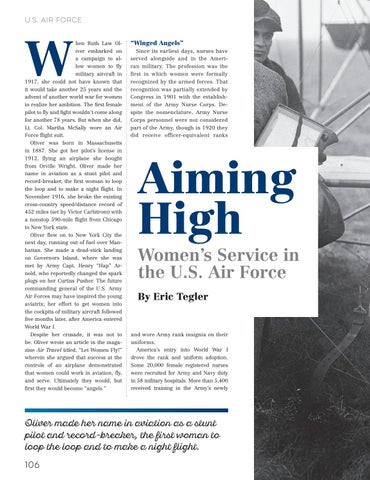U.S. AIR FORCE “Winged Angels” Since its earliest days, nurses have served alongside and in the American military. The profession was the first in which women were formally recognized by the armed forces. That recognition was partially extended by Congress in 1901 with the establishment of the Army Nurse Corps. Despite the nomenclature, Army Nurse Corps personnel were not considered part of the Army, though in 1920 they did receive officer-equivalent ranks
Aiming High Women’s Service in the U.S. Air Force By Eric Tegler
and wore Army rank insignia on their uniforms. America’s entry into World War I drove the rank and uniform adoption. Some 20,000 female registered nurses were recruited for Army and Navy duty in 58 military hospitals. More than 5,400 received training in the Army’s newly
Oliver made her name in aviation as a stunt pilot and record -breaker, the first woman to loop the loop and to make a night flight. 106
PHOTO CREDIT
W
hen Ruth Law Oliver embarked on a campaign to allow women to fly military aircraft in 1917, she could not have known that it would take another 25 years and the advent of another world war for women to realize her ambition. The first female pilot to fly and fight wouldn’t come along for another 78 years. But when she did, Lt. Col. Martha McSally wore an Air Force flight suit. Oliver was born in Massachusetts in 1887. She got her pilot’s license in 1912, flying an airplane she bought from Orville Wright. Oliver made her name in aviation as a stunt pilot and record-breaker, the first woman to loop the loop and to make a night flight. In November 1916, she broke the existing cross-country speed/distance record of 452 miles (set by Victor Carlstrom) with a nonstop 590-mile flight from Chicago to New York state. Oliver flew on to New York City the next day, running out of fuel over Manhattan. She made a dead-stick landing on Governors Island, where she was met by Army Capt. Henry “Hap” Arnold, who reportedly changed the spark plugs on her Curtiss Pusher. The future commanding general of the U.S. Army Air Forces may have inspired the young aviatrix; her effort to get women into the cockpits of military aircraft followed five months later, after America entered World War I. Despite her crusade, it was not to be. Oliver wrote an article in the magazine Air Travel titled, “Let Women Fly!” wherein she argued that success at the controls of an airplane demonstrated that women could work in aviation, fly, and serve. Ultimately they would, but first they would become “angels.”
